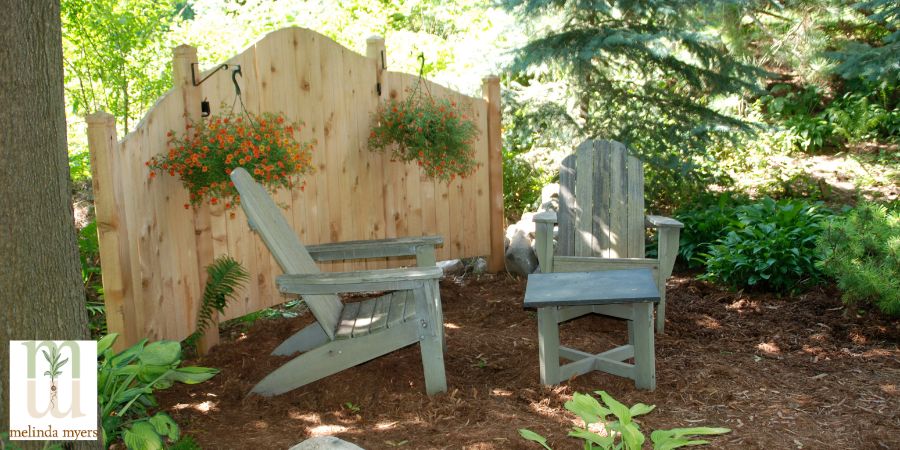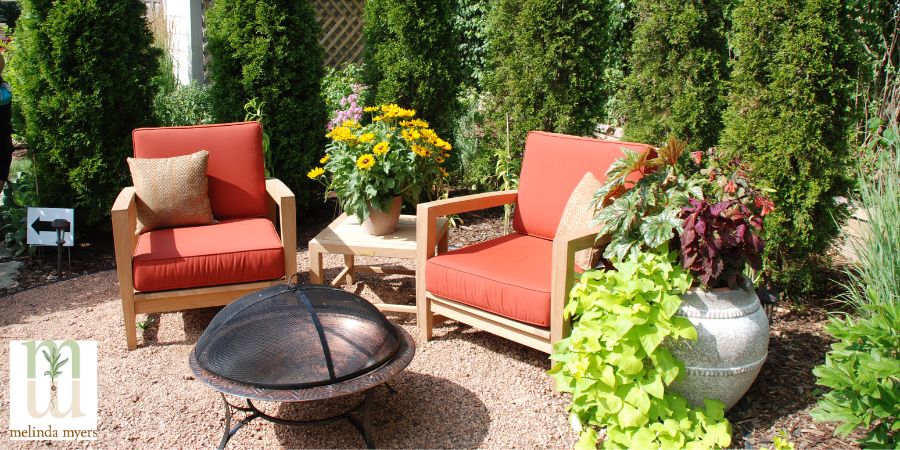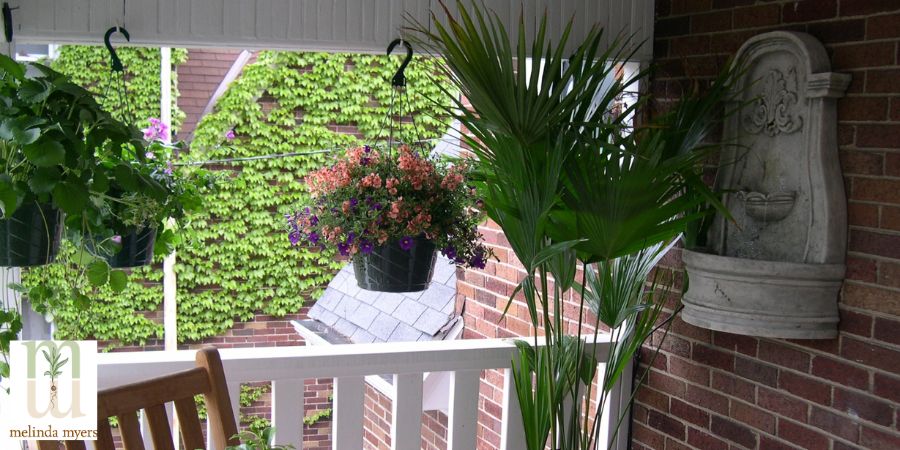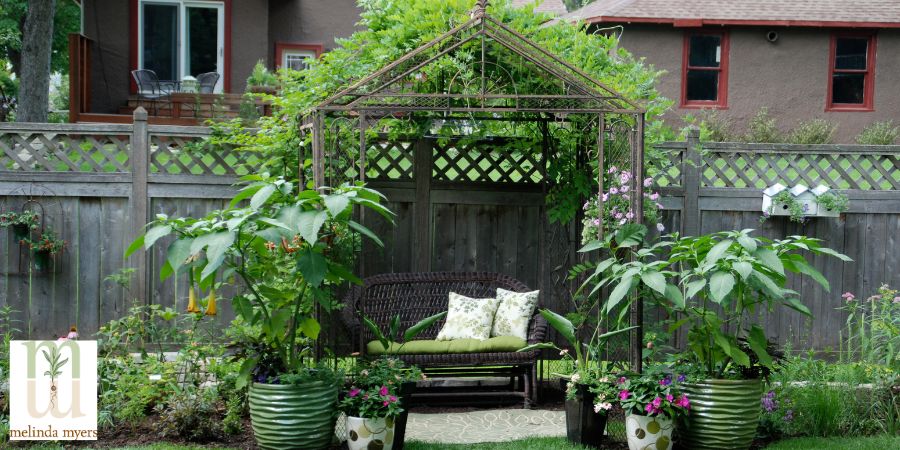Create a Backyard Oasis with Plants
- horticulturist and gardening expertMay 25, 2024
Create your own piece of paradise right in your backyard, on your balcony, patio, or deck. Fill your backyard oasis garden with a collection of plants that provide texture, color, and the privacy you’ll need and want when creating a backyard retreat.
Plan first, then go shopping. I know it is hard to resist all those beautiful plants, new introductions, and unique varieties you find at your favorite garden center. It is too easy to fill your cart with loads of beautiful plants that won’t fit or thrive in your backyard oasis. We have all done this and planning first may not eliminate the urge but may reduce the number of misguided purchases.
Start by identifying the space you want to transform. Select a conveniently located area that allows you to easily retreat to the space when you want to relax, read, have a private conversation or enjoy a meal. Don’t let a lack of room prevent you from creating your very own oasis. Take advantage of underutilized spaces. I have seen city gardeners create small space retreats with just a chair, colorful pillow, small table, and plantings conveniently located around the corner from their back door or under a shade tree.
Once you select the location on your patio, deck, balcony, or space in the yard, evaluate the surroundings. Define the space with decorative screens, fencing, a gazebo, or plantings. Before enclosing the whole space, identify the views you need to screen and those you want to keep. Perhaps a view of your favorite flower garden, the park across the street, or your neighbor’s water feature extends your enjoyment beyond the limits of your garden oasis. Frame these views with plantings, openings in structures, or old window frames.

Fence and trees as a barrier
Use tall grasses, large tropical plants, and upright shrubs and trees to define the space. Espalier trees on fences, train vines onto trellises and mount containers on walls to soften these structures with a bit of greenery.
When I lived in the city my upstairs balcony was a favorite space of mine and my visitors. I used tall tropical plants and hanging baskets to screen the view of my neighbor’s upstairs windows and the alley. I left the view looking north open to the line of large shade trees on the county easement. The trees not only provided privacy but made me feel like I was sitting aloft in a forest right in the heart of the city.
As you begin the design process, consider how you want to use the space, a style that complements your personality and, of course, fits within your budget. Look for ways to make your plant budget go further. Permanent plantings help reduce yearly plant costs and can provide a framework and backdrop for yearly plantings. Phasing in big changes allows you to create a usable space now that becomes your dream outdoor sanctuary in time.
Save money by purchasing smaller perennial plants and watching them grow into large specimens over time. Fill the voids between young shrubs and perennial vines on trellises with annual plants. As the shrubs and perennial vines grow you will need fewer annuals each year. Purchase less expensive varieties to fill the space and include a few of the more expensive plants as focal points in gardens and containers. Repurpose found items into containers that reflect your style and personality. Just add drainage holes, fill with potting mix and plants.
Getting started on a design can be overwhelming. Selecting a focal point such as a decorative fountain, fire pit, or piece of garden art can help. Use the colors, form, and style of the focal point to inspire the space.

Oasis around the fire pit
Make color and texture work for you in the plants, furnishings, and decorations you select for your oasis. Warm colors of red, yellow and orange can help you create a warm, cozy and even cheerful atmosphere while cool colors of blue, green and violet provide a more serene environment. Cool colors can also help an area feel cooler and larger.
Use color echoing to create unity and balance in the space. Repeating similar colors between plants, furnishings, and structures also provides a sense of harmony.
Include fine textured plants with small narrow leaves and flowers like grasses to create a backdrop for other plants. Use them to create a light airy feel and make small areas seem larger. Bold plants have larger leaves and flowers and are the attention grabbers in any garden or container. Include these for a more tropical feel and to make larger spaces feel smaller perhaps more intimate.

Containers hanging on the porch
Keep your design and plant selections simple so you can truly relax in the space. Not only is it important to select plants suited to the sunlight, soil, moisture, and climate, but they should also fit the size and shape of the space when mature. Including plants that are too big for the space means you will need to prune more often and have more trimmings to manage.
Look for low-maintenance plants that need little or no deadheading, are disease and insect resistant and won’t quickly overtake neighboring plants. You’ll spend less time tending and more time enjoying these healthy, beautiful specimens.
Consider selecting plants for your backyard plant sanctuary that provide multiple benefits. Look for ones that deliver several seasons of beauty with their flowers, colorful foliage, seedheads or berries, and fall color. Consider plants that add a welcome fragrance to the space and help attract pollinators, adding motion and color to your backyard oasis.
Double your plantings for greater impact. Plant equally assertive plants that require the same growing conditions together. Combine plants that bloom at the same time to boost the floral display or at different times to extend the bloom time. For example, plant early-season bulbs among perennials for two seasons of color. As the perennials emerge their foliage helps hide the fading leaves of the bulbs. Train two vines either with similar or different bloom times onto the same support to maximize the beauty of that vertical space.
Keep your plants healthy by watering thoroughly as needed. Plant tags and other gardening resources can help you determine if the plants need consistently moist, well-drained soil or tolerate and even prefer drier soil. Mulch the soil surface with a layer of leaves, evergreen needles, or other organic material to help suppress weeds, conserve moisture, and improve the soil as it breaks down. Fertilize your plants and containers at the start of the season with low nitrogen slow release Milorganite. It contains 85% organic matter, feeding the soil as well as the plants, and won’t burn the plants when the weather turns hot and dry. Make a second application about 6 to 8 weeks later if needed.
Add a bit of shade as needed. A deciduous shade tree can provide cooling shade for summer and let warming sunlight into the space during the cooler months. Train vines over a pergola to do the same thing. Keep in mind it will impact the amount of sunlight reaching the plants below. Grape vines are often used for their beauty and tasty fruit. Unfortunately birds and squirrels may also enjoy the harvest and leave a mess behind. Umbrellas and canvas sails are other shade options to consider.

Pergola
Add a bit of sparkle to the space with flower-filled containers. Change these with the change of seasons. Pansies, stocks, snapdragons, and sweet alyssum shine during the cooler months. Tropicals, cannas, heliotrope, annual vinca, coleus, impatiens, and so many more thrive in warmer weather.
Extend your enjoyment into the evening with some lighting. Light up the area and pathways to your retreat with candles or landscape lighting. Be mindful of birds and night-flying insects when lighting up your space. Use shields to point light down to the ground versus into the night sky. Select those with lower lumens that aren’t as bright but still provide sufficient light and ambiance for you. Avoid white and blue light and opt for ambers and yellow-greens that are less disruptive to the birds and night flying pollinators.
Help keep mosquitoes away by lighting a few citronella candles and placing them near you and others enjoying the space. Use a fan to help keep you cool and keep the weak flying mosquitoes away.
Like any decorating and gardening project be ready to make needed adjustments. As you and others spend time in the space you may need to add more plants, containers, or seating, and adjust your screening strategies. And as your plants grow and mature you will find even greater joy in your backyard plant oasis.

